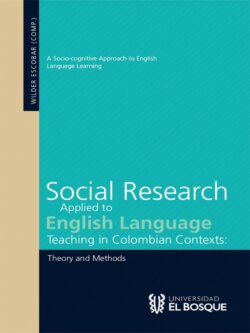Читать книгу Social research applied to english language teaching in Colombian contexts - Wilder Yesid Escobar Alméciga - Страница 12
На сайте Литреса книга снята с продажи.
Path of Motion
ОглавлениеAs demonstrated above, such classifications of typology stress the importance of path of motion in the construction of motion events in verb– and satellite–framed languages. The satellite, although not a lexical category in its own right, represents a semantic function inherent in s-framed languages: that of displaying the path (p) or trajectory of the figure (f ), or the locative element in a motion event. Note that, according to Talmy (2000), a motion event may be defined as “a situation containing motion, or the continuation of a stationary location alike” (p. 25); therefore, the figure may be considered to participate in a motion event that is either that of translational motion (1a), or simply that of maintaining a stationary position (1b). The following examples are provided to demonstrate the difference of the motion events described above:
(1a) The boy (f) got out of (p) the chair.
(1b) The boy (f) sat up (p) anxiously in the chair.
Both of these phrases demonstrate the completion of an action that is either translational in nature (1a), or that describes the perpetuation of a spatial position (1b). The action of getting out of a chair clearly delineates a change of location, while that of sitting up maintains the spatial position, albeit with a change of posture.
In verb-framed languages, however, such syntactic constructions are not possible. In her work on linguistic typology, Ibarretxe-Antuaño (2004, 2009, 2012) clearly establishes the elaboration of path in verb-framed languages. Whereas satellite-framed languages routinely express path via a satellite, in verb-framed languages “the core information is not expressed in a separate element, but usually conflated with the verb” (Ibarretxe-Antuaño, 2012, p. 6). This idea is clearly expressed in the following examples of grammatical phrases in Spanish:
(2a) El alpinista (f) descendió la montaña.
(2b) El bebé (f) se incorporó solo.
These examples clearly establish that the motion verbs (descender; incorporarse) inherently contain an element of path that their English counterparts do not (to go down, to sit up). Here, it becomes clear that the English verbs most frequently appear in a verb phrase to fully confer the semantic meaning of the motion event. Verb-framed languages, conversely, tend to conflate both motion and path within the verb itself.
The dichotomy of verb construction between verb- and satellite-framed languages becomes even more profound when considering sentences with multiple motion events. As established above, path of motion is most often encoded outside of the verb in a satellite in s-framed languages, therefore permitting multiple motion events to be associated with the same verb as demonstrated in (3a) and (3b):
(3a) He (f) fell down(p) the hill and into(p) the river.
(3b) She (f) ran down(p) the stairs and out(p) the door.
From the examples (3a) and (3b), we see that the verbs to fall and to run can take multiple satellites thus collocating separate motion events onto the same verb. To emphasize this notion, (3a) and (3b) could be written in the manner of (3c) and (3d):
(3c) [He (f) fell down the hill] and [he (f) fell into the river]
(3d) [She (f) ran down the stairs] and [she (f) ran out the door]
For the sake of brevity, native-like English discourse would never contain expressions of this style. Instead, the verbs to fall and to run are simply assigned multiple satellites that each represent the distinct events clarified in (3c) and (3d). As a result of this paradigm, infinite multiple satellite constructions are possible in English and are quite frequent in colloquial speech. Additional examples of grammatical English sentences that follow this model include:
(i) He went in the main entrance and straight to the mayor’s office.
(ii) The children got out of the sun and into the shade.
(iii) The bird flew out of the nest and over to the feeder.
(iv) We walked up the hill and down the other side.
(v) I went in the door, down the hallway, around the corner, and out the back.
The verb phrases present in these sentences denote more than one event of motion by the addition of multiple path satellites. From this model, it is not a stretch of the imagination to deduce the grammaticality of (v) which expresses four motion events on the verb to go solely via the addition of path satellites.
This multiple-event expression, however pervasive in the verb phrases of satellite-framed English, is grammatically impossible in languages with verb-framed motion event expression. As Brown and Gullberg (2010) explain, in verb-framed languages “comparable information is spread across [separate] clauses, each associated with different path verbs” (p. 266). As path is often conflated on the verb in verb-framed languages, the Spanish translation of (3a) and (3b) respectively must be written as follows in order to retain grammaticality:
(4a) Él se cayó de la montaña y se sumergió en el río.
(4b) Ella bajó la escalera corriendo y salió por la puerta.
As demonstrated by (4a) and (4b), the path of motion is distinctly encoded in each of the verbs and, therefore, motions following dissimilar paths must be expressed via separate clauses. The verbs caerse and sumergirse both inherently carry within the verb nucleus a path of motion, that of the figure falling downward toward the ground referent, or the figure entering the ground referent respectively. As such, verb-framed languages accomplish the task of communicating the previous event of a man falling down the mountain and into the river differently than would a satellite-framed language. Whereas Spanish requires the use of separate motion/path verbs, English permits the use of the aggregation of satellites to a verb phrase to express multiple paths of motion.
